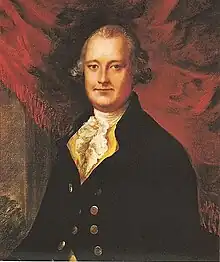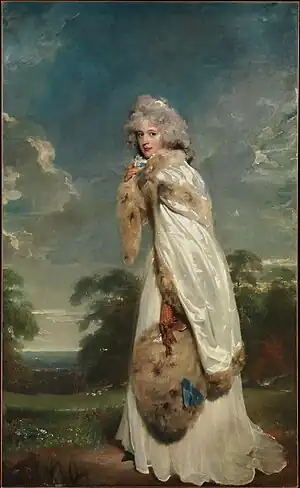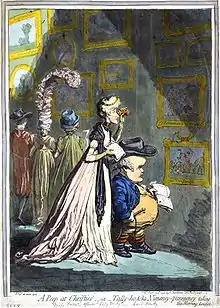Edward Smith-Stanley, 12th Earl of Derby
Edward Smith-Stanley, 12th Earl of Derby PC (1 September 1752 O.S.[1] – 21 October 1834), usually styled Lord Stanley from 1771 to 1776, was a British peer and politician of the late eighteenth and early nineteenth centuries. He held office as Chancellor of the Duchy of Lancaster in 1783 in the Fox–North coalition and between 1806 and 1807 in the Ministry of All the Talents.
The Earl of Derby | |
|---|---|
 | |
| Chancellor of the Duchy of Lancaster | |
| In office 29 April 1783 – 17 December 1783 | |
| Monarch | George III |
| Prime Minister | The Duke of Portland |
| Preceded by | The Lord Ashburton |
| Succeeded by | The Earl of Clarendon |
| In office 12 February 1806 – 31 March 1807 | |
| Monarch | George III |
| Prime Minister | The Lord Grenville |
| Preceded by | The Lord Harrowby |
| Succeeded by | Hon. Spencer Perceval |
| Personal details | |
| Born | 1 September 1752 (O.S.) [12 September 1752 (N.S.)] |
| Died | 21 October 1834 |
| Nationality | British |
| Political party | Whig |
| Spouse(s) | Lady Elizabeth Hamilton (1753–1797) Elizabeth Farren (d. 1829) |
| Children | Edward Smith-Stanley, 13th Earl of Derby Lady Charlotte Hornby Lady Elizabeth Henrietta Cole |
| Parent(s) | James Smith-Stanley, Lord Strange Lucy Smith |
| Alma mater | Trinity College, Cambridge |
Background and education
Derby was the son of James Smith-Stanley, Lord Strange (1716–1771), son of Edward Stanley, 11th Earl of Derby (1689-1776). His mother was Lucy Smith, a daughter and co-heiress of Hugh Smith of Weald Hall, Essex. His father had assumed the additional surname and arms of Smith by private Act of Parliament in 1747.[2] Derby entered Eton College in 1764, proceeding to Trinity College, Cambridge in 1771.[3]
Political career
Derby was returned to Parliament as one of two representatives for Lancashire in 1774, a seat he held until 1776,[4] when he succeeded his grandfather in the earldom and entered the House of Lords.[5] He served as Chancellor of the Duchy of Lancaster between April and December 1783[5][6] in the Fox-North Coalition headed by the Duke of Portland and was sworn into the Privy Council the same year.[6] He remained out of office for the next 23 years but was once again Chancellor of the Duchy of Lancaster between 1806 and 1807 in the Ministry of All the Talents headed by Lord Grenville.[5]
Lord Derby also served as Lord Lieutenant of Lancashire between 1776 and 1834.[5] He was also listed as a subscriber to the Manchester Bolton & Bury Canal navigation in 1791.[7]
Horse racing
At a dinner party in 1778 held on his estate "The Oaks" in Carshalton, Lord Derby and his friends planned a sweepstake horse race, won the following year by Derby's own horse, Bridget. The race, The Oaks, has been named after the estate since. At a celebration after Bridget's win, a similar race for colts was proposed and Derby tossed a coin with Sir Charles Bunbury for the honour of naming the race. Derby won, and the race became known as the Derby Stakes. Bunbury won the initial race in 1780 with his horse, Diomed; Derby himself won it in 1787 with Sir Peter Teazle.[8]
His racing colours were black with a white cap.[9]
His influence on racing has been described as "crucial".[10]
Cockfighting and gamefowl
Lord Derby's love for racing was surpassed only by his passion for gamefowl and cockfighting.[11] As a game fowl breeder, Derby is said to have influenced contemporaries by proving that systematic breeding could be combined with a learned familiarity of one's fowl through daily, attentive care, to increase success.[12][13]
During his lifetime, Lord Derby established a family of gamefowl, which would remain popular for nearly 200 years after his death.[12]
Derby built a cockpit in Preston at his own expense, and fought there or at Liverpool race meets. He and fellow cocker, General Yates, held annual cockfighting contests with regular stakes between 1,000-3,000 guineas to the winner.[12]
According to an obituary:
So strong was the Earl's addiction to his favourite sport, that cocks have been introduced into his drawing-room, armed and spurred, even during the latter days of his life.[11]
For much of his career, Lord Derby employed a top feeder of the time, Paul Potter, to oversee his training. Potter's son handled these duties later in Lord Derby's life, and would, upon Lord Derby's death, receive possession of all Derby's birds, spurs, bags and fighting equipment, including the silk bags used for transporting the fowl, embroidered in Lord Derby's colours with the image of a fighting cock. He is thought to be the last member of the peerage to openly participate in the sport.[12]
Family
%252C_Twelfth_Earl_of_Derby%252C_with_His_First_Wife_(Lady_Elizabeth_Hamilton%252C_1753%E2%80%931797)_and_Their_Son_(Edward_Smith_Stanley%252C_1775%E2%80%931851)_MET_DP169403.jpg.webp)
Lord Derby married Lady Elizabeth, daughter of James Hamilton, 6th Duke of Hamilton, on 23 June 1774. They had three children:
- Edward Smith-Stanley, 13th Earl of Derby (21 April 1775 – 30 June 1851); married his cousin Charlotte Margaret Hornby, daughter of Reverend Geoffrey Hornby by his wife, the Hon. Lucy Hornby (née Smith-Stanley)
- Lady Charlotte Stanley (17 October 1776 – 25 November 1805); married her cousin Edmund Hornby, Esq., son of Reverend Geoffrey Hornby by his wife, the Hon. Lucy Hornby (née Smith-Stanley)
- Lady Elizabeth Henrietta Stanley (29 April 1778 – 4 November 1857); married Stephen Thomas Cole, Esq., of Stoke Lyne, Oxfordshire, and Twickenham, and had issue.
In the late 1770s, Lady Derby had a very public affair with John Frederick Sackville, 3rd Duke of Dorset. In 1779, the countess moved out of Lord Derby's house, leaving their children behind, apparently expecting that her husband would agree to a divorce and that the Duke would then marry her. About one year after she left his house, Lord Derby made it known that he had no intention of divorcing his wife; at the same time, he continued to deny her access to her children. The countess was socially ostracised for the remainder of her life. Historian Peter Thomson suggests that the third of the couple's children, Lady Elizabeth Henrietta, was the result of Lady Derby's affair with Dorset. Despite this, the Earl of Derby cared for the child after his wife left him.[14]
Lady Derby died at the age of 44 on 14 March 1797. Six weeks later, on 1 May 1797, Lord Derby married the actress Elizabeth Farren, daughter of George Farren. They had a daughter:
- Lady Mary Margaret Stanley (died December 1858); married Thomas Egerton, 2nd Earl of Wilton.
Lord Derby survived his second wife by five years and died on 21 October 1834, aged 82. He was succeeded in the earldom by his son from his first marriage, Edward, Lord Stanley.[5]
%252C_Countess_of_Derby.jpg.webp) Portrait of Elizabeth, Countess of Derby, by George Romney, ca 1776-1778
Portrait of Elizabeth, Countess of Derby, by George Romney, ca 1776-1778 Portrait of Elizabeth Farren, by Thomas Lawrence, 1790
Portrait of Elizabeth Farren, by Thomas Lawrence, 1790 Arms of Stanley, Earl of Derby: Argent, on a bend azure three buck's heads cabossed or. Painted in 1781
Arms of Stanley, Earl of Derby: Argent, on a bend azure three buck's heads cabossed or. Painted in 1781
References

- Edward was born on 1 September 1752 according to his entry in the baptismal register of St John's church, Preston: see "The Parish of St John, Preston in the County of Lancashire". Lancashire OnLine Parish Clerks. Retrieved 5 July 2018.Parish registers for St. John's Church, Preston, 1642–1948. Preston, Lancashire: Church of England, St. John's Church. 30 April 2005. Retrieved 7 July 2018. Online; electronic images of LDS microfilm 1278740, image 418 of 2102 (closeup of entry) Two days after his birth, the provisions of the Calendar (New Style) Act 1750 came into effect, as Britain converted to the Gregorian calendar, so that Wednesday, 2 September was immediately followed by Thursday, 14 September. In many modern secondary sources (e.g. Cokayne et al. 1916; Brooke 1964; Cox 1974, p. 15; Crosby 2004) his birth date is given as 12 September 1752, which is a retrospective conversion of 1 September to the New Style calendar.
- Act (1747) 21 Geo.2 c.4 "Enabling James Stanley, Lord Strange, and his issue to take the surname Smith and to bear the arms of Smith and Heriz"
- "Stanley, the Hon. Edward (Smith) (STNY771E)". A Cambridge Alumni Database. University of Cambridge.
- "Stanley, Edward, Lord Stanley (1752–1834)". History of Parliament Online. Retrieved 15 November 2017.
- "Person Page".
- "No. 12470". The London Gazette. 26 August 1783. p. 1.
- A list of the subscribers to the intended Bolton Bury and Manchester Canal Navigation. Manchester, Bolton and Bury Canal Company. 1791. Greater Manchester County Records Office, ref. E4/78/419
- Thoroughbred Heritage: Sir Peter Teazle Retrieved 23 November 2010
- Weatherby, Edward and James (1801). "Colours worn by the riders of the following noblemen, gentlemen, &c". Racing Calendar. 28: 52.
- Barrett, Norman, ed. (1995). The Daily Telegraph Chronicle of Horse Racing. Enfield, Middlesex: Guinness Publishing.
- "The Earl of Derby". Gentleman's Magazine. n.s. 2 (2): 644–47. December 1834. hdl:2027/njp.32101013596414 – via HathiTrust.
- Gilbey, Walter (1912). Sport in the olden time. London: Vinton. p. 81. doi:10.5962/bhl.title.30159.
- The Cocker; humbly inscribed to those gentlemen who are amateurs of the Game Cock ... By a Gentleman who has been in the habit of breeding these eight and twenty years [i.e. W. Sketchley]. [With blank forms.]. J. Croft: Burton on Trent; Longman, Hurst, Rees, Orme, & Brown: London. 1814. OCLC 557931720.
- Thomson 2004.
Works cited
- Brooke, John (1964). "Stanley, Edward, Lord Stanley (1752–1834)". In Namier, Lewis; Brooke, John (eds.). The History of Parliament: the House of Commons 1754–1790. Vol. 3. London: Secker & Warburg. pp. 467–8.
- Cokayne, George Edward; Gibbs, Vicary; Doubleday, H. Arthur, eds. (1916). Complete Peerage of England, Scotland, Ireland, Great Britain and the United Kingdom, Extant, Extinct or Dormant (Dacre to Dysart). Vol. 4 (2nd ed.). London: St Catherine Press. pp. 218–9.
- Cox, Millard (1974). Derby: the life and times of the 12th Earl of Derby, Edward Smith Stanley (1752–1834) founder of the two world famous horse races, the Derby and the Oaks. London: J. A. Allan. ISBN 0851311997.
- Crosby, Alan G. (2004). "Stanley, Edward Smith, twelfth earl of Derby (1752–1834)". Oxford Dictionary of National Biography (online ed.). Oxford University Press. doi:10.1093/ref:odnb/47080. (Subscription or UK public library membership required.)
- Thomson, Peter (2004). "Farren, Elizabeth [married name Elizabeth Smith Stanley, countess of Derby] (1759x62–1829)". Oxford Dictionary of National Biography (online ed.). Oxford University Press. doi:10.1093/ref:odnb/9191. (Subscription or UK public library membership required.)
Further reading
- Bagley, J. J. (1985). The Earls of Derby, 1485–1985. London: Sidgwick & Jackson. pp. 143–54. ISBN 0283991526.
- Stanley, Peter Edmund (1998). The House of Stanley: the history of an English family from the 12th century. Edinburgh: Pentland Press. ISBN 1858215781.